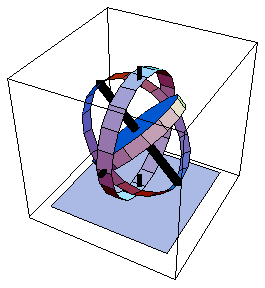10.3.3 3D Example MechanismThe following mechanism is a simple gyroscope that, dynamically, is not a very simple mechanism. The gyroscope consists of three moving bodies: the base, the gimbal, and the rotor. The base is constrained to rotate about a vertical axis affixed to the ground, while the gimbal rotates about a horizontal axis affixed to the base, and the rotor is constrained to rotate about a fixed axis on the gimbal that is orthogonal to the gimbal's horizontal rotational axis on the base.
The model is defined so that the origins of each body are always coincident, and so that each body is initially aligned with the global coordinate system, therefore no initial guesses are required because the default initial guesses are exact. The two Orthogonal1 constraints 2 and 4 are present only so that the model can be assembled in a fixed state. They will be dropped to find the free response. A single parameter freq is included in the model to specify the angular speed of the rotor, relative to the gimbal. The gyroscope is modeled in local, angular coordinates so that the angular velocities of interest appear directly in the solution rules.
All of the bodies are massless except the rotor. This makes the results much easier to interpret. The moments of inertia of the rotor are representative of a thin disk.
Only one load is applied to the model, a moment applied to the base in the Z direction. Initially this moment has no effect because the base is prevented from rotating by constraint 2. However, when the constraints that prevent the base and gimbal from rotating are dropped, the orthogonal reaction to the moment applied to the base can be observed at the rotor. This loads the Modeler3D package and defines names for each of the body numbers. Here are the constraints, bodies, and loads for the gyroscope model. Here is the gyroscope with the gimbal rotated to make a better picture.

The model is run at T = 0.1 so that initial conditions are available for SolveFree.
Out[26]= |  |
|